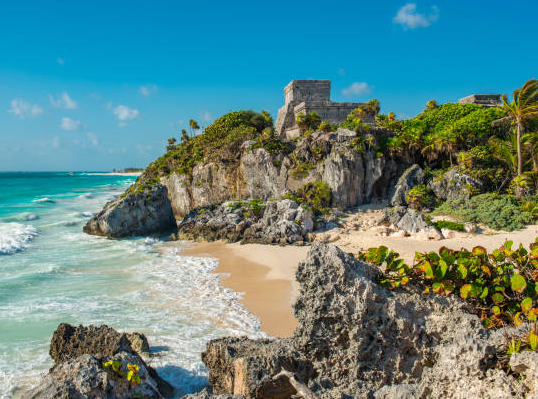Overlooking the Caribbean Sea, several temple ruins sparkle in the sun. These are relics of past civilizations, which the Maya used to call “Zama”, which means “dawn”. Today, Tulum is a center for spiritual pilgrims. Although this Mexican town has soared in popularity and become a holiday destination, its ancient core remains.

Tulum is one of the only sites along the coast with Mayan ruins, originally a port that reached its peak between the 13th and 16th centuries. The archaeological area of Tulum preserves the existing buildings. Perched atop a cliff, the Templo del Dios de Viento is named after the god of wind, and is said to whistle in high winds, signaling the impending dangerous weather. Templo del Dios Descentente features reliefs of the famous descending gods, who are often depicted inverted. He is associated with Ah Muzen Cab, a key figure in Mayan mythology, or the god of bees and honey. Honey was an important commodity for the Mayans, traded between Tulum and the city of Coba,45 kilometers away. Here, the Pyramid of Nohochmur also depicts revered gods in its temples.
Tulum’s most famous site is the 7.5-meter-tall El Castillo. It used to be a lighthouse and place of worship for newcomers to merchants. Walk to the beach below, where Mayan canoes will stop and swim under the gaze of the towering ruins. To experience the abundant marine life, head deeper for snorkeling trips. Tulum is part of the second largest Mesoamerican coral reef in the world. It stretches from Mexico to Honduras and is home to more than 60 species of corals and more than 500 species of fish.

Tulum is famous not only for its diving opportunities, but also for its holy pools inland. About 20 minutes from the beach, there are many cenote wells, which are groundwater wells formed by collapsed limestone. From the quietly open crystal wells and Escondido cenotes, to the wildly popular large cenotes, where caves attract divers, these sinkholes offer blissful resting places away from the heat. The Maya believed that they were a life-giving source of water and a gateway to the underworld.
While contemporary Tulum may be full of hotels and boutiques, traces of its spiritual roots abound. If you’re looking for a fresh beginning, come here to travel and be guided by the wisdom of the past.
